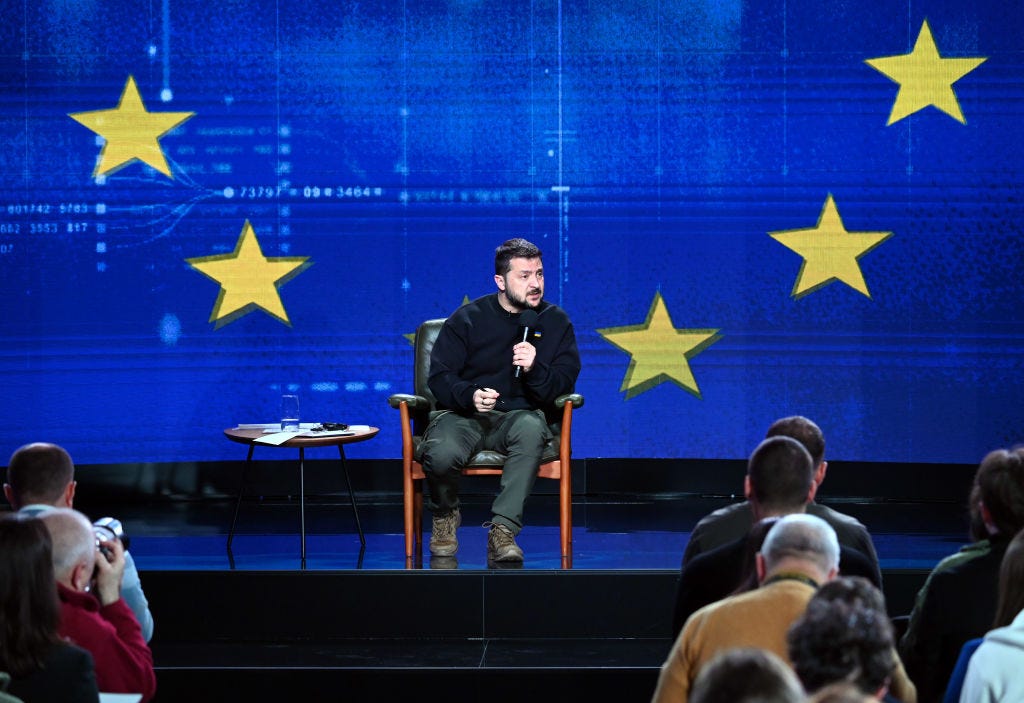The Endless War in Ukraine
Echoes of the First World War
As Israel’s war in Gaza rages on, the second great conflict in the world threatens to slip out of the national consciousness. Russia’s invasion of Ukraine has lasted nearly two years and maximalists on each side have no reason to come to the negotiating table. Vladimir Putin’s army has proved incapable of conquering Ukraine; it also cannot be easily repelled from the east. Volodymyr Zelensky wants Ukraine to join NATO, which could precipitate a far larger and deadlier war.
In the Nation, I argued it’s time to negotiate a ceasefire. This is a very unpopular position that has become slightly more popular because the ballyhooed Ukrainian counteroffensive has not succeeded. This is not the fault of the Ukrainians. It is how modern warfare operates, with the most sophisticated weaponry benefiting the troops who are on the defensive. This is why Russia storming through Europe, blitzkrieg-style, is a fantasy. Putin the tyrant can’t even seize Ukraine. But what the Russians can do is defend their position and pile up Ukrainian casualties. The math here is daunting because Russia is a far larger nation. Putin can afford to send ever more Russian men to their deaths. Russia is built for the slog, the stalemate.
And that’s what this is—a bloody and terrible stalemate. In 2022, I pointed out the contours of the conflict resembled the First World War’s, and this is very true today. World War Two analogies need to be discarded. This is the war before us.
From my Nation piece:
Few commentators in the West wanted to acknowledge the long shadow of World War I; just as in the 1910s, rapid technological advances had inordinately strengthened the power of military defenses. Mobile drones and anti-aircraft missiles dominate today’s battlefield, eviscerating conventional tanks and attack helicopters. What worked against Russia in the early months of the war—a dug-in military that could effectively counterstrike—would now confound Ukraine.
Despite this, calls for a negotiated peace were dismissed as little more than the appeasement of fascists. Ukraine, with its own fraught democracy and furious crackdowns on dissent, was recast, in Manichean fashion, as a heroic beacon, beyond reproach. Whatever its president, Volodymyr Zelensky, demanded of the United States and Europe must be granted; for certain Democratic and Republican members of Congress, a blank check for the war effort and what amounted, in short order, to an American proxy war with Russia would be the only course of action.
The logic of utter Russian defeat never held because Russia is a far larger country than Ukraine. Russia can lose 150,000 troops and call up more. The Wehrmacht could not defeat the Soviet army in a war of attrition. There’s little reason to believe, even with more time—more casualties, a greater risk of nuclear escalation—all of Ukraine’s battleground objectives will be achieved. It still remains controversial to say that the United States should help decide how this war ends, but the US funds the Ukrainian military, provides crucial intelligence and training, and does everything short of funnel young Americans to the front, even if Lloyd Austin, the secretary of defense, occasionally threatens politicians with that bleak possibility.
How does peace get done? The United States, which has pumped tens of billions into the war effort and is steering what amounts to a proxy war with Russia, must take the lead, along with Europe. A peace will be ugly because Russia cannot be completely broken or driven out. A peace will not be karmic. But it is necessary, now, before the bloodletting drags on for a third year. If the war continues on its course, it can last another two, three, or four years. It can go longer. The danger is greater than any faced in the 1910s because Russia and the United States have the largest nuclear stockpiles on Earth. The nuclear threat must be fully reckoning with. Even the Cold Warriors sought to avoid, whenever possible, direct conflict with Russia.
Few in the Biden administration seem to be thinking this way. Rather, they promise this or that piece of technology will deliver the vaunted breakthrough.
The Biden administration wanted Congress to swiftly approve $60 billion more. It was left to Republicans, and a few dissident Democrats, to ask how exactly the money would be spent and how it would guarantee the victory that was supposed to be imminent. The Stinger missiles, the Patriot missiles, the Javelin missiles, and the Leopard tanks were all supposed to win the war. Cluster munitions, which world governments have tried to ban because they kill and maim so many civilians, were the essential weapons needed to “dislodge” the Russians forces, according to the RAND Corporation. American taxpayers are rightfully wary. They never voted to indefinitely finance a war being waged many thousands of miles away.
When each of these escalatory weapons fail to deliver the breakthroughs promised, the default of the American and Ukrainian governments is to simply demand more, with pliant media in each nation to bang the drum for perpetual conflict.
Will there be an appetite for diplomacy in 2024? No one actually knows. All that can be predicted for now is more death.



I agree that we should do whatever we can to end the war and unnecessary bloodshed, but I disagree with some of your premises. This is not a stalemate, and Russia will continue a steady advance while it degrades Ukraine's military force. Don't confuse the lack of "big arrow" offensives with a lack of progress. Also, the numbers of Russian casualties taken as true in western media are insanely high and not to be trusted
"Will there be an appetite for diplomacy in 2024?"
Not amongst those that make the decisions. The war serves the only thing they care about - money.
The military industrial complex is making a fortune. They donate generously.